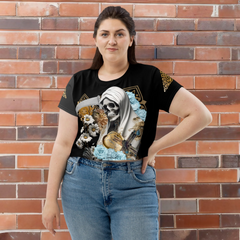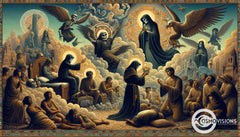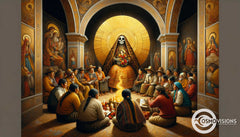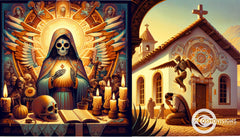Understanding Santa Muerte: Exploring the Mysteries and Rituals of Mexican Spirituality
Posted by Luciano Martucci

Are you fascinated by the spiritual mysteries that swirl around Mexico's enigmatic figure, Santa Muerte? Many find themselves drawn to this powerful symbol of death and wonder about the role she plays in Mexican culture.
Often misunderstood, Santa Muerte stands as a beacon to those seeking solace or protection outside conventional religious paths.
Here's something you might not know: Santa Muerte is not recognized by the Catholic Church but has a huge following among various communities. Through exploring her history, rituals, and symbolism we can gain insight into why so many feel connected to La Flaquita (the Skinny Lady).
By delving into this blog post, you will uncover secrets of Mexican spirituality and understand how the veneration of Santa Muerte provides comfort and guidance for countless devotees.
Ready to unravel the mysteries? Keep reading to discover more!
Understanding Santa Muerte: A Brief History
Santa Muerte has ancient origins, dating back to indigenous Mexican cultures, and has evolved into a popular folk saint in Mexico. The history of Santa Muerte reflects the intertwining of indigenous beliefs with Catholicism, resulting in a unique spiritual figure that holds great significance for many Mexicans.
Ancient Origins of Santa Muerte
Long before the Spanish set foot in the New World, death had a significant place in Mexican culture. The Santa Muerte's ancient origins lie deep within pre-Hispanic traditions that honored deities symbolizing death and the afterlife.
These indigenous beliefs formed a foundation for what would become the modern representation of Santa Muerte.
Indigenous groups, such as the Aztecs, revered figures akin to La Parca of today’s lore. They held rituals and ceremonies for gods who personified death, believing these entities governed over mortal destinies and acted as guides to life beyond.
As European influences blended with Latin customs, these ancestral veneration practices gradually fused into what we now recognize as devotion to Santa Muerte—Holy Death personified.
Santa Muerte's Mexican Roots
Santa Muerte's presence in Mexico weaves through the country's vast tapestry of spiritual practices. Rooted deeply within the culture, her figure emerges as a profound symbol blending indigenous Aztec beliefs with Spanish Catholic influences.
This fusion creates a unique religious figure that holds special significance for everyday Mexicans, especially among the clases populares who feel connected to tangible expressions of their faith.
Her followers turn to her for protection, love, and guidance, carrying out venerations that show respect and seek favors from this powerful personification of death.
Devotees fill their homes with altars bearing images and amulets of La Santísima Muerte. They light candles and offer prayers hoping she will intercede on behalf of those who revere her; whether it’s asking for healing or seeking justice in an often harsh world.
These traditions underscore Santa Muerte’s role as a beacon for those facing life’s hardships—a folk saint embodying both compassion and strength as seen through the eyes of countless believers across generations.
Now let us delve into 'The Symbolism of Santa Muerte', where every color and object associated with her reveals part of this enigmatic spiritual force’s story.

The Symbolism of Santa Muerte
Santa Muerte's symbolism is rich and complex, reflected in the colors of her gown, the objects she holds, and the guardians at her feet. Understanding these symbols provides insight into the spiritual significance of Santa Muerte in Mexican culture.
The Colors of Her Gown
Santa Muerte's gown shimmers in a spectrum of colors, each woven with its own profound meaning. Followers choose these hues to align their intentions with the spiritual energy she radiates. Here's how different colors communicate distinct desires:
- White: Purity and cleansing are at the heart of her white tunic, making it the most common choice among devotees. This color symbolizes a fresh start or a desire for peace.
- Black: Reserved for more somber rituals, the black gown embodies release from negative influences. It oversees endings and personal reflection, guiding individuals through transitions.
- Red: Passion and love find expression in Santa Muerte’s red attire. This vibrant color draws on her power to ignite romance or strengthen relationships.
- Green: Worn to attract justice, luck, and prosperity, green represents growth and financial success. Those seeking legal aid or career advancements often turn to this hue.
- Blue: The calming shade of blue is associated with wisdom and mental clarity. Petitioners look to this color for truth-seeking and healing in emotional matters.
- Gold or Yellow: Candles burn bright beside her gold-draped figure when worshippers seek abundance. Yellow can also imply health improvements and well-being.
- Purple: Invoking psychic abilities and deeper spirituality, purple serves as a bridge to higher understanding. It helps individuals tap into their intuition.
The Objects She Holds
Santa Muerte is often depicted holding a globe, symbolizing her global influence. The scythe she holds represents death and the transition between life and death, while the scale symbolizes justice and fairness.
- Globe: Represents Santa Muerte's influence over various aspects of life, including global matters and worldly affairs. It signifies her presence as a powerful force beyond borders.
- Scythe: Symbolizes the concept of death and transformation, reflecting Santa Muerte's role as a guide in the transition from one state of being to another.
- Scale: Represents justice, balance, and fairness in decisions related to life and death. It illustrates Santa Muerte's role as an arbiter and guardian of moral order within Mexican spirituality.
The Guardians at Her Feet
The book "The Guardians at Her Feet" delves into the rich history, meaning, and worship of Santisima Muerte. It explores the individual elements of Santa Muerte iconography and veneration along with their possible origins, including Precolumbian, European, and Latin influences.
This detailed exploration provides insight into the rituals and practices associated with Santa Muerte worship, as well as the cultural and social significance of this spiritual figure.
The enigmatic identity of Santa Muerte and her significance in Mexican popular culture are also thoroughly discussed in the book.

Santa Muerte: A Folk Saint for the Marginalized
Santa Muerte plays a significant role in the Day of the Dead, especially for marginalized communities. Her representation as a folk saint provides comfort and solace to those who feel excluded from traditional religious practices.
Santa Muerte's Role in the Day of the Dead
Santa Muerte plays a significant role in the Day of the Dead, offering solace and comfort to those who are facing mortality or grieving lost loved ones. She provides a sense of belonging and support for individuals who may feel excluded from traditional religious practices.
Santa Muerte's presence during this time offers hope and spiritual guidance to those on the fringes of society, underscoring her reputation as a folk saint for the marginalized.
During the Day of the Dead, Santa Muerte is celebrated as a guardian and protector, embodying empathy and understanding for all who seek her intercession. Her role transcends cultural boundaries, resonating deeply with people who have experienced social exclusion or marginalization.
Mysteries and Rituals Associated with Santa Muerte
The rituals and mysteries associated with Santa Muerte include creating an altar for her and offering prayers, as well as exploring the power of love through spiritual practices. These rituals are important aspects of Mexican spirituality and hold a deep significance for those who follow the traditions of Santa Muerte.
An Altar and Prayer for Santa Muerte
To venerate Santa Muerte, creating an altar is crucial. This sacred space should be kept free from negative energies and demons, symbolizing respect for the folk saint. Here are important components to include in the altar and a guide to prayer for Santa Muerte:
- The Altar:
- A statue or image of Santa Muerte, often depicting her in different colors representing different aspects of life.
- Offerings such as candles, incense, flowers, and food items that hold significance to the practitioner and the folk saint.
- Cleansing elements like water, salt, and herbs for maintaining spiritual purity.
- Prayer for Santa Muerte:
- Begin by lighting a candle and setting an offering on the altar.
- Address Santa Muerte respectfully using her titles and praise her attributes.
- Express gratitude for any favors granted or seek assistance while facing challenges.
- Close the prayer with a gesture of devotion such as crossing oneself or bowing.
- Observe any changes in the candle flames or smoke during prayer as possible signs from Santa Muerte.
- Pay attention to any feelings or insights that may arise after prayers as potential messages from the folk saint.
Exploring the Power of Love with Santa Muerte
Santa Muerte's cult is deeply associated with the potent force of love miracles. Devotees venerate her seeking love, faithfulness, and protection in their relationships. The rituals performed at her altar reflect the intense belief in the ability of Santa Muerte to manifest profound connections between individuals.
Adherents believe that Santa Muerte can bring about transformative experiences in matters of the heart, demonstrating a powerful connection to love miracles within the cult. This unwavering devotion showcases how deeply rooted the concept of love is within rituals associated with Santa Muerte.

The Controversy Surrounding Santa Muerte
Opposition from the Church and state has sparked controversy over the worship of Santa Muerte. There are varying beliefs about her role in Mexican spirituality and society, leading to debates over her legitimacy as a folk saint.
Church Opposition
The Catholic Church views Santa Muerte as satanic and blasphemous, rejecting the unofficial icon as contrary to traditional Catholic doctrine. This stance has led many individuals to seek spiritual guidance from alternative sources, turning away from the traditional church.
Despite the significant role of Santa Muerte in Mexican spirituality and cultural practices, the opposition from the Catholic Church has contributed to a growing divide between official religious institutions and marginalized communities seeking solace in non-traditional saints.
State Opposition
The state opposition to Santa Muerte is evident in the concerns over inspired and ritualistic killings associated with the cult potentially crossing the border into the United States.
In Mexico, officials have taken measures to discourage devotion to Santa Muerte due to her embodiment of opposition to traditional religious and societal norms. This controversial figure has faced active suppression from state authorities, reflecting their disapproval of her presence and influence.
Efforts by both Mexican and U.S. authorities reflect a shared concern regarding the potential spread of Santa Muerte's influence, particularly as it pertains to criminal activities and societal disruption.
Santa Muerte: Saint of the Dispossessed, Enemy of Church and State
Santa Muerte empowers marginalized individuals to resist their societal disenfranchisement. Her worship provides solace and strength for those facing social exclusion, poverty, or discrimination.
Despite opposition from the Catholic Church and state authorities, she has garnered immense popularity as a folk saint in Mexico.
Misconceptions have led to Santa Muerte being wrongly associated with criminal elements, particularly drug traffickers. However, her role as the patroness of the dispossessed is at the heart of her significance within Mexican spiritual traditions.






















